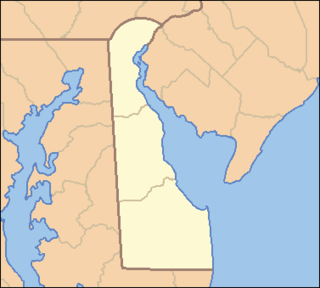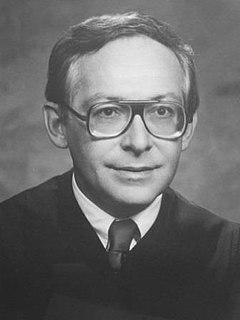
The United States courts of appeals are the intermediate appellate courts of the United States federal judiciary. The courts of appeals are divided into 11 numbered circuits that cover geographic areas of the United States and hear appeals from the U.S. district courts within their borders, the District of Columbia Circuit, which covers only Washington, D.C., and the Federal Circuit, which hears appeals from federal courts across the United States in cases involving certain specialized areas of law. The courts of appeals also hear appeals from some administrative agency decisions and rulemaking, with by far the largest share of these cases heard by the D.C. Circuit. Appeals from decisions of the courts of appeals can be taken to the U.S. Supreme Court.

The United States Court of Appeals for the Ninth Circuit is a federal court of appeals that has appellate jurisdiction over the U.S. district courts in the following federal judicial districts:

The United States Court of Appeals for the First Circuit is a federal court with appellate jurisdiction over the district courts in the following districts:

The United States Court of Appeals for the Second Circuit is one of the thirteen United States Courts of Appeals. Its territory comprises the states of Connecticut, New York and Vermont. The court has appellate jurisdiction over the district courts in the following districts:

The United States Court of Appeals for the Third Circuit is a federal court with appellate jurisdiction over the district courts for the following districts:

The United States Court of Appeals for the Seventh Circuit is the U.S. federal court with appellate jurisdiction over the courts in the following districts:
Circuit courts are court systems in several common law jurisdictions. The core concept of circuit courts requires judges to travel to different locales to ensure wide visibility and understanding of cases in a region. More generally, the term may also refer to a court that merely holds trials and other proceedings at a series of multiple locations in some kind of rotation.
In the United States, federal judges are judges who serve on courts established under Article Three of the U.S. Constitution. Often known as "Article Three judges", they include the chief justice and associate justices of the U.S. Supreme Court, the circuit judges of the U.S. Courts of Appeals, the district judges of the U.S. District Courts, and the judges of the U.S. Court of International Trade.

The United States District Court for the District of Delaware is the Federal district court having jurisdiction over the entire state of Delaware. The Court sits in Wilmington. Currently, four district judges and five magistrate judges preside over the court.

The United States Court of Appeals for the Federal Circuit is a United States court of appeals that has special appellate jurisdiction over certain types of specialized cases in the U.S. federal court system. It has exclusive appellate jurisdiction over all U.S. federal cases involving patents, trademarks, government contracts, veterans' benefits, public safety officers' benefits, federal employees' benefits, and various other categories. Unlike other federal courts, the Federal Circuit has no jurisdiction over cases involving criminal, bankruptcy, immigration, or U.S. state law.
The United States circuit courts were the original intermediate level courts of the United States federal court system. They were established by the Judiciary Act of 1789. They had trial court jurisdiction over civil suits of diversity jurisdiction and major federal crimes. They also had appellate jurisdiction over the United States district courts. The Judiciary Act of 1891 transferred their appellate jurisdiction to the newly created United States circuit courts of appeals, which are now known as the United States courts of appeals. On January 1, 1912, the effective date of the Judicial Code of 1911, the circuit courts were abolished, with their remaining trial court jurisdiction transferred to the U.S. district courts.
Senior status is a form of semi-retirement for United States federal judges. To qualify, a judge in the federal court system must be at least 65 years old, and the sum of the judge's age and years of service as a federal judge must be at least 80 years. As long as senior judges carry at least a 25 percent caseload or meet other criteria for activity, they remain entitled to maintain a staffed office and chambers, including a secretary and their normal complement of law clerks, and they continue to receive annual cost-of-living increases. Senior judges vacate their seats on the bench, and the president may appoint new full-time judges to fill those seats.

The Supreme Court of the United States is the highest court in the federal judiciary of the United States. The procedures of the Court are governed by the U.S. Constitution, various federal statutes, and its own internal rules. Since 1869, the Court has consisted of one chief justice and eight associate justices. Justices are nominated by the president, and with the advice and consent (confirmation) of the U.S. Senate, appointed to the Court by the president. Once appointed, justices have lifetime tenure unless they resign, retire, or are removed from office.

Bruce Marshall Selya is a Senior United States Circuit Judge of the United States Court of Appeals for the First Circuit and former chief judge of the United States Foreign Intelligence Surveillance Court of Review who is known for his distinctive writing style.
A chief judge is the highest-ranking or most senior member of a lower court or circuit court with more than one judge. According to the Federal judiciary of the United States, the chief judge has primary responsibility for the administration of the court. Chief judges are determined by seniority. The chief judge commonly presides over trials and hearings. In the Supreme Court of the United States the highest-ranking member is the Chief Justice of the United States.
The Court of Claims was a federal court that heard claims against the United States government. It was established in 1855, renamed in 1948 to the United States Court of Claims, and abolished in 1982. Then, its jurisdiction was assumed by the newly created United States Court of Appeals for the Federal Circuit and United States Claims Court, which was later renamed the Court of Federal Claims.
John Clifford Wallace is a Senior United States Circuit Judge of the United States Court of Appeals for the Ninth Circuit and previously was a United States District Judge of the United States District Court for the Southern District of California.
A judicial panel is a set of judges who sit together to hear a cause of action, most frequently an appeal from a ruling of a trial court judge. Panels are used in contrast to single-judge appeals, and en banc hearings, which involves all of the judges of that court. Most national supreme courts sit as panels.









